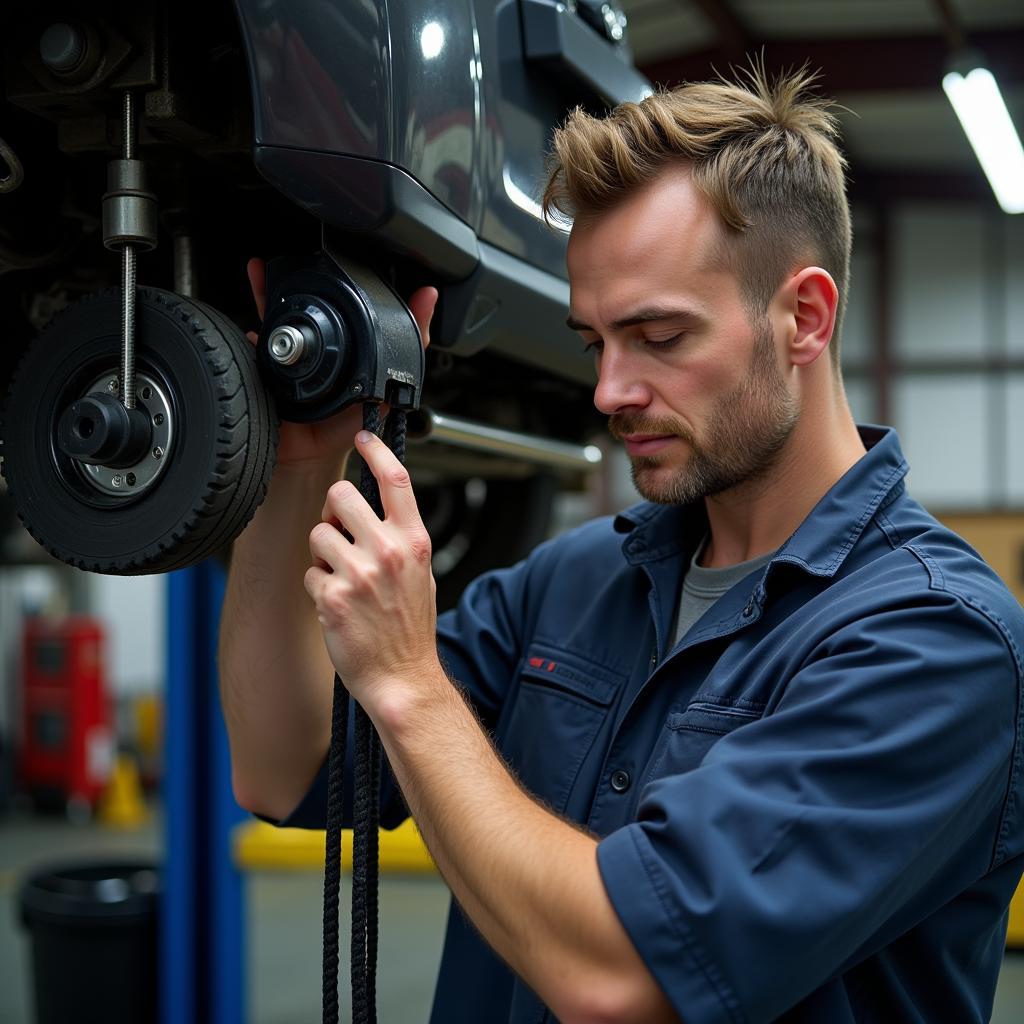Car Lift Pulley Problems can bring your shop to a screeching halt, impacting productivity and potentially creating safety hazards. This guide delves into the common issues plaguing these crucial components, offering practical solutions for both car owners and professional mechanics. We’ll cover everything from routine maintenance to troubleshooting complex issues, empowering you to keep your lifts operating smoothly.
Understanding the intricate workings of your car lift’s pulley system is the first step towards effective maintenance and repair. A seemingly minor problem, like a frayed cable or a worn pulley bearing, can quickly escalate, leading to costly downtime. For help with other car problems you can check out this article car lift problems.
Identifying Common Car Lift Pulley Problems
Several signs indicate potential pulley problems. Listen for unusual noises like squeaking, grinding, or clicking emanating from the pulley system. These sounds often suggest bearing wear or cable fraying. Visually inspect the cables for signs of wear and tear, such as broken strands or kinks. A jerky or uneven lift movement can also indicate pulley issues. Lastly, check for excessive slack in the cables, which can compromise the lift’s stability.
 Worn Car Lift Pulley Cable Showing Fraying and Damage
Worn Car Lift Pulley Cable Showing Fraying and Damage
Why Do Pulleys Fail?
Pulleys are subject to constant stress, especially in busy workshops. Regular wear and tear is inevitable. Lack of lubrication leads to increased friction and premature wear of pulley bearings. Overloading the lift beyond its capacity puts undue strain on the entire system, including the pulleys. Environmental factors like moisture and corrosive chemicals can also contribute to pulley degradation. Sometimes, even the car window regulator can be an issue, as explained in car window regulator problems.
Troubleshooting and Repairing Car Lift Pulley Issues
Before attempting any repairs, ensure the lift is properly lowered and secured, and power is disconnected. If you’re unsure about any step, consult a qualified lift technician.
How to Inspect Your Car Lift Pulleys
- Visual Inspection: Carefully examine all pulleys for cracks, chips, or deformation.
- Cable Check: Inspect cables for fraying, kinks, or broken strands. Replace damaged cables immediately.
- Bearing Check: Rotate each pulley to check for smooth movement. Any grinding or resistance indicates bearing wear.
- Lubrication: Ensure all pulley bearings are adequately lubricated. Use a high-quality lubricant recommended by the lift manufacturer.
- Slack Adjustment: Check and adjust cable tension according to the manufacturer’s instructions.
 Mechanic Inspecting Car Lift Pulley System for Damage and Wear
Mechanic Inspecting Car Lift Pulley System for Damage and Wear
When Should I Replace My Car Lift Pulleys?
Replace pulleys exhibiting significant wear, cracks, or damage. Don’t wait for a catastrophic failure. Preventive maintenance is crucial for safety and optimal lift performance. You might also encounter issues with your Forward 9000 car lift, as detailed in this article: forward 9000 car lift problems.
“Regular inspection and timely replacement of worn pulleys is paramount to ensuring the longevity and safety of your car lift,” advises John Miller, Senior Automotive Lift Technician at LiftRight Solutions. “Ignoring minor issues can lead to more significant and costly problems down the line.”
Preventing Car Lift Pulley Problems
Regular maintenance is key to preventing pulley problems. Establish a routine lubrication schedule and adhere to it diligently. Keep the lift area clean and free of debris that could interfere with the pulley system. Never exceed the lift’s weight capacity. Regularly inspect the pulleys and cables for signs of wear and address any issues promptly. Have a professional technician perform annual inspections and preventative maintenance to catch potential problems early on.
“Preventive maintenance is not an expense; it’s an investment in the safety and longevity of your equipment,” adds Maria Rodriguez, Lead Mechanic at AutoTech Solutions. “A little proactive care can save you a lot of trouble and expense in the long run.” If you’re interested in testing your general car knowledge, you can try our can you diagnose car problems quiz.
Conclusion
Car lift pulley problems can be disruptive and potentially dangerous. By understanding the common causes, implementing regular maintenance procedures, and addressing issues promptly, you can ensure the smooth and safe operation of your car lift. Regular inspections and timely repairs are essential for minimizing downtime and maximizing the lifespan of your equipment. Remember, safety should always be the top priority when working with car lifts. For any assistance or further questions, don’t hesitate to contact us at AutoTipPro. Our office is located at 500 N St Mary’s St, San Antonio, TX 78205, United States, and our phone number is +1 (641) 206-8880. We’re always ready to help keep your lifts running smoothly.





Leave a Reply